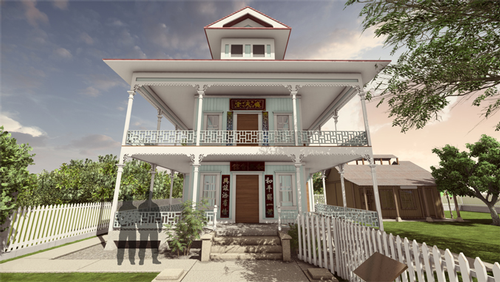MONDAY, APRIL 1, 2024
Students at the University of Hawaii’s Manoa School of Architecture are learning to digitally restore buildings in Lahaina using virtual 3D modeling and artificial intelligence.
The course was reportedly developed in response to the Maui wildfires last year. While state officials have reported that rebuilding the town could take three to five years, there have been calls to build many damaged, centuries-old buildings to their original stature.
“Rebuilding Lahaina in Mixed Reality” focuses on “preservation through memory and engagement through sharing.” It has been designed to impart technical skills and “foster a deep appreciation for the historical and cultural context of Lahaina. “
Students reportedly had the opportunity to speak with experts from the Hawaii State Preservation Department and architectural practitioners to discuss potential stakeholders involved in rebuilding the architectural heritage.
“This project allows students to understand the importance of historical preservation through studying what happened in Lahaina and understanding the human connection to a place/building, or the sense of place,” said Joyce Lin, an architecture student currently enrolled in the course.
“We can also utilize existing technology to recreate historical and existing buildings, allowing people to experience the space and environment even from far away and possibly even assist in future developments and reconstructions of buildings.”

 |
| University of Hawaii |
|
Students at the University of Hawaii’s Manoa School of Architecture are learning to digitally restore buildings in Lahaina using virtual 3D modeling and artificial intelligence. |
Some of the buildings that students are designing include the Wo Hing Society Hall, Masters Reading Room, Baldwin House and the Old Lahaina Courthouse.
“I think that this project is important for architecture students in the sense that it offers us a different pathway. One might think that architecture is all about new designs and new buildings, but sometimes it can be about saving/preserving old ones,” said Karly Tangonan, an architecture student currently enrolled in the course.
The integration of digital model-making and AI has opened new possibilities for preserving architectural history, providing accessibility for students to appreciate the rich history of Lahaina. Some of the buildings students have been designing in mixed reality include Wo Hing Society Hall, Masters Reading Room, Baldwin House and Old Lahaina Courthouse.
“I think this class has changed the way I look at digital model-making and AI, and I have gained an appreciation for what this could offer for the future of historic preservation,” said Jennifer Rodriguez Flores, an architecture student currently enrolled in the course.
According to the university, the course is helping to shape future architects who are equipped with both traditional and cutting-edge skills and to contribute to the preservation and evolution of architectural history.
“Prior to this course, I was not familiar with the concept of AI and the opportunities that it held,” said Michelle Lee, an architecture student currently enrolled in the course.
“However, it has offered a hands-on approach to rebuilding Lahaina through digital modeling and AI to provide an immersive experience to users.”
The collaboration also includes Dean William Chapman and Professor Hyoung-June Park in the School of Architecture, and Professor Kyung Hoon Hyun, a design computing specialist from Hanyang University in Korea.
“Using this digital heritage technology aids people in creating or reconstructing a building more accurately,” said Hyun, a design computing specialist from Hanyang University in South Korea.
Hyun adds that students are using the same technologies as experts did to redesign the Notre Dame Cathedral that burned in Paris in 2019
“We want students to expand their creativity to think of more than simply rebuilding what was destroyed, but also what they can do with this new 3D model that they created,” Hyun said. “They can add values or communal experiences within the community of Lahaina.”
The project's primary goals reportedly include preservation through memory and engagement through sharing.
“Preservation through memory is like not only we want to have a photo-realistic reconstruction of the building itself, but also at the same time we want to share the experience people had in the previous buildings,” Park said.
While the project focused on a few historic buildings, Chapman said much more could be done using AI and 3D virtual modeling.
“You can take it back to different eras, and visit Lahaina in 1840, visit Lahaina in 1900, and visit Lahaina just before the fire,” he said. “I think those are all potentials.”
Tagged categories: Architects; Architecture; Colleges and Universities; Color + Design; Commercial / Architectural; Design; Design - Commercial; Digital tools; Fire; Historic Preservation; Historic Structures; Maintenance + Renovation; Preservation; Program/Project Management; Projects - Commercial; Research and development; Technology